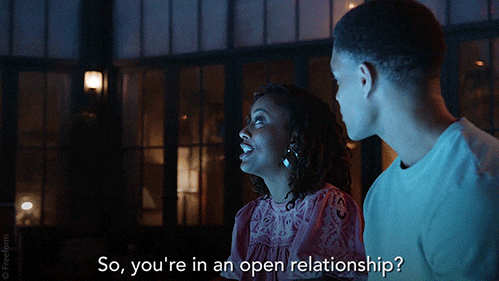Welcome to the intriguing world of open relationships, where boundaries are pushed and love takes on new meanings. This article delves into the complexities and dynamics of non-monogamous partnerships, uncovering why increasing numbers of couples are exploring alternative relationship structures.
In a society that often insists on monogamy as the norm, open relationships challenge societal expectations and offer individuals the freedom to express their desires and navigate multiple romantic connections. With trust, communication, and consent at the core, open relationships challenge traditional notions of fidelity and exclusivity, giving rise to a unique set of rules and negotiations within each partnership.
FOR ADULTS ONLY
Join us as we explore the experiences and perspectives of those in open relationships, examining the benefits, challenges, and misconceptions surrounding this unconventional lifestyle. Whether you’re curious about exploring alternative relationship structures or expanding your understanding of modern love, this article intrigues and enlightens you. Get ready to expand your horizons and step into a world where love knows no boundaries.
What are open relationships?
Open relationships are romantic partnerships in which individuals agree to engage in emotional and sexual relationships with other people outside their primary relationship. This arrangement contrasts sharply with traditional monogamous relationships, in which partners commit exclusively to one another.
In open relationships, partners establish a framework that allows for multiple romantic or sexual connections, often grounded in principles of honesty and consent. Such arrangements can take various forms, reflecting the unique needs and desires of those involved, but they fundamentally challenge the conventional boundaries of love and fidelity.
In many open relationships, the emphasis lies on the mutual understanding that all parties are aware of and consent to the involvement of others. This transparency is crucial, fostering a sense of trust and respect among partners. Communication is vital; partners must regularly discuss their feelings, desires, and any changes in dynamics to ensure everyone remains on the same page. While the concept may seem daunting or unconventional to some, many find that open relationships can lead to deeper connections, enhanced intimacy, and greater personal freedom.
Moreover, the motivations for entering an open relationship can be diverse. Some couples seek to explore their sexuality more freely, while others may desire to build stronger emotional connections with multiple partners. For some, open relationships solve issues like mismatched libidos or the desire for variety without sacrificing their primary bond. Regardless of the reasons, open relationships represent a significant shift in how love can be understood and experienced in modern society.
The history and evolution of open relationships
The concept of open relationships is not a novel phenomenon; it has roots that can be traced back through various cultures and historical periods. Throughout history, many societies have accepted or even encouraged non-monogamous arrangements. For instance, some Indigenous cultures in North America practiced polyamory as a norm, with communal parenting and shared resources playing a critical role in their social structures. Similarly, ancient civilizations such as the Greeks and Romans often embraced sexual freedom, with a range of consensual arrangements existing alongside marriage.
In more recent times, the sexual revolution of the 1960s and 1970s played a pivotal role in reshaping societal attitudes toward relationships. This era challenged traditional notions of love and fidelity, advocating for sexual liberation and the exploration of alternative relationship structures. As feminist ideals gained traction, the critique of monogamy emerged, highlighting the constraints it imposed on personal identity and sexual expression. This cultural shift paved the way for more open discussions about non-monogamous relationships, allowing individuals to explore their desires without fear of judgment.
The advent of the internet in the late 20th and early 21st centuries further catalyzed the evolution of open relationships. Online forums and platforms dedicated to alternative lifestyles provided resources and community support for those who felt isolated in their experiences. The ease of communication and the Availability of information allowed individuals to connect with like-minded partners, fostering a more accepting environment for open relationships. As societal norms continue to evolve, the understanding and acceptance of open relationships are gaining momentum, challenging long-standing beliefs about love and commitment.
Types of open relationships
Open relationships encompass a variety of configurations, each tailored to the preferences and boundaries of those involved. One common type is the “swinging” relationship, where couples engage in sexual activities with other couples or individuals, often in a social setting. This arrangement focuses primarily on physical encounters rather than emotional connections, allowing partners to explore their sexuality in a consensual and playful manner. Swinging can be an exciting way for couples to enhance their intimacy while enjoying the thrill of shared experiences.
Another type is polyamory, which involves maintaining multiple romantic relationships simultaneously, with the knowledge and consent of everyone involved. Unlike swinging, polyamory emphasizes emotional connections in addition to physical ones. Individuals in polyamorous relationships may have deep bonds with multiple partners, each relationship potentially taking on its unique characteristics. This model allows for a broader exploration of love and intimacy, accommodating the diverse emotional needs of those involved.
Additionally, some couples may choose to engage in a “monogamish” arrangement. This term, popularized by author Dan Savage, refers to a primarily monogamous relationship with occasional allowances for sexual encounters outside the partnership. This type of relationship typically involves clear boundaries and specific agreements about what is acceptable, allowing couples to enjoy the benefits of non-monogamy while maintaining a solid primary bond. Each type of open relationship highlights the fluidity and diversity of modern love, showcasing the myriad ways individuals can connect and flourish outside traditional norms.
Benefits and challenges of open relationships
Open relationships offer numerous benefits, appealing to those seeking greater freedom and exploration in their romantic lives. One of the primary advantages is the opportunity for personal growth and self-discovery. Engaging with multiple partners can provide individuals with new perspectives, experiences, and insights about their desires, needs, and boundaries. This journey of exploration often fosters deeper self-awareness, allowing individuals to understand better what they seek in love and relationships.
Moreover, open relationships can significantly enhance communication skills. To navigate the complexities of multiple connections, partners must engage in honest and open dialogue about their feelings, desires, and potential issues. This emphasis on communication can strengthen the primary relationship as partners learn to express their emotions more effectively and empathetically. Additionally, the trust built through navigating an open relationship can lead to a more profound bond as partners rely on one another for support and understanding.
However, open relationships also come with their own set of challenges. Jealousy and insecurity can surface as partners explore connections with others, creating tension and emotional strain. These feelings can be exacerbated by societal stigma surrounding non-monogamy, leading individuals to question their worth or the strength of their primary relationship. Establishing and maintaining boundaries can also be complex, as partners must regularly re-evaluate their agreements and adapt to changing emotions and circumstances. The delicate balance of freedom and commitment requires ongoing effort and negotiation, which may only suit some.
Communication and trust in open relationships.
Effective communication is the cornerstone of any successful relationship, but it takes on heightened importance in open relationships. Partners must cultivate an open and honest dialogue about their feelings, desires, and experiences with other partners. This level of transparency helps build trust and mitigate misunderstandings, ensuring everyone feels valued and respected. Regular check-ins and discussions about boundaries, rules, and feelings can help maintain a healthy dynamic and foster a deeper emotional connection between partners.
Trust is equally vital in open relationships. Partners need to feel confident that their significant other is genuinely committed to the relationship and that their feelings will be considered and respected. Building trust often requires time and consistency, as partners demonstrate reliability through their words and actions. Establishing clear agreements can also enhance trust, as partners understand the expectations and limits set within the relationship. This clarity helps to alleviate anxiety and fosters a sense of security, allowing individuals to explore their connections with others without fear of betrayal.
Furthermore, navigating the complexities of open relationships necessitates a willingness to engage in difficult conversations. Partners must confront their feelings of jealousy, insecurity, or discomfort head-on, addressing any issues that may arise constructively. Doing so creates an environment where both partners feel safe expressing their emotions and needs. This proactive approach strengthens the primary relationship and enhances the overall experience of engaging with others, leading to richer connections and personal growth.
Navigating jealousy and insecurity in open relationships
Jealousy and insecurity are common emotions that can arise in open relationships, often stemming from fears of inadequacy or concerns about losing one’s partner. Acknowledging these feelings is crucial, providing valuable insight into individual insecurities and relationship dynamics. Rather than suppressing or ignoring these emotions, partners should strive to understand their origins and communicate them openly. This exploration process can lead to deeper intimacy and help partners develop strategies for managing jealousy healthily.
One practical approach to navigating jealousy is establishing transparent and open communication channels. Partners should regularly check in with one another about their feelings, discussing any insecurities or concerns that may arise. By fostering an environment of honesty and vulnerability, individuals can support each other in processing their emotions and developing coping strategies. This ongoing dialogue strengthens the bond between partners and promotes a culture of understanding and empathy.
Additionally, reframing jealousy as an opportunity for growth rather than a threat is essential. Rather than viewing jealousy as a negative emotion, partners can use it as a catalyst for self-reflection and personal development. By examining the underlying causes of their jealousy, individuals can gain valuable insights into their desires and needs. This perspective shift can lead to a more profound understanding of oneself and one’s partner, ultimately enriching the relationship and enhancing emotional connections with others.
Common misconceptions about open relationships
Despite the growing visibility of open relationships, numerous misconceptions persist, often leading to misunderstanding and stigma. One prevalent myth is that individuals in open relationships are less committed to their primary partner. In reality, many couples choose non-monogamy to strengthen their bond and enhance their emotional intimacy. Open relationships require high commitment, trust, and communication, often leading to deeper connections between partners as they navigate their feelings and desires together.
Another common misconception is that open relationships are simply a cover for infidelity. This belief stems from the deeply ingrained societal norms surrounding monogamy and fidelity. However, open relationships are based on mutual consent and transparency, distinguishing them from deceitful behaviors associated with cheating. In an open relationship, both partners are aware of and agree to the involvement of others, fostering an environment of trust and respect often lacking in traditional infidelity.
Additionally, some people assume that open relationships are solely about sexual freedom, neglecting the emotional aspects that can be equally significant. While many individuals in open relationships may explore sexual connections with others, emotional intimacy is often a crucial component. Partners may seek to build meaningful connections with multiple people, enriching their emotional landscape and allowing for a broader understanding of love and affection. Recognizing these nuances is essential in challenging misconceptions and promoting a more nuanced understanding of open relationships.
How to establish boundaries in open relationships
Establishing boundaries is fundamental to open relationships, as it helps create a framework for navigating multiple connections while maintaining trust and respect. The first step in this process is open communication. Partners should candidly discuss their needs, desires, and potential concerns. This dialogue lets both individuals articulate their expectations and ensures everyone feels heard and valued.
Once both partners have expressed their thoughts, they can collaboratively develop a set of boundaries that resonate with both parties. These boundaries may encompass various aspects, such as emotional connections, sexual encounters, and time spent with other partners. It’s essential to approach this process flexibly, as boundaries may evolve. Regular check-ins can help partners assess whether their agreements are still working or if adjustments are necessary based on their experiences and feelings.
Additionally, it is crucial to recognize that boundaries are not solely about restrictions but also about empowering individuals to express themselves authentically. Partners should feel comfortable setting limits that prioritize their emotional well-being while allowing room for exploration. By fostering an environment where both partners can voice their needs and concerns, open relationships can thrive on mutual respect and understanding, ultimately enhancing the overall experience of love and connection.
Tips for maintaining a healthy, open relationship
Maintaining a healthy, open relationship requires ongoing effort, communication, and a commitment to personal growth. Here are some essential tips for individuals navigating this unconventional lifestyle:
- Prioritize communication: Regularly check in with your partner about feelings, experiences, and any changes in dynamics. Open dialogue fosters trust and ensures that both partners feel heard and valued.
- Revisit boundaries: As relationships evolve, so too may your boundaries. Schedule periodic discussions to assess whether your agreements are still working and adjust as needed to accommodate changing emotions and circumstances.
- Practice self-awareness: Reflect on your feelings and desires regularly. Understanding your emotions can help you communicate your needs effectively and navigate any challenges within the relationship.
- Cultivate trust: Trust is the foundation of a healthy, open relationship. Be reliable and transparent with your partner, demonstrating your commitment to the relationship through your words and actions.
- Embrace jealousy: Recognize jealousy as a natural emotion that can arise in non-monogamous relationships. Instead of suppressing these feelings, engage in open dialogue, using them as opportunities for growth and understanding.
- Seek community support: Engage with others who share similar experiences. Online forums, support groups, or local meetups can provide valuable insights and connections, helping you feel less isolated in your journey.
Conclusion: Is an open relationship right for you?
Deciding whether an open relationship is right for you is a deeply personal choice that requires careful consideration of your values, desires, and relationship dynamics. While open relationships can offer unique opportunities for growth, exploration, and deeper emotional connections, they also demand high communication, trust, and self-awareness. It is essential to reflect on your motivations for pursuing non-monogamy and whether you and your partner are aligned in your desires and goals.
Engaging in open relationships may only be suitable for some. Some individuals may find comfort and fulfillment in traditional monogamous partnerships, while others may thrive in the freedom and exploration that non-monogamy offers. Having honest conversations with your partner about your feelings, desires, and concerns is crucial, ensuring that both parties feel comfortable and respected in their choices.
Pursuing an open relationship should be rooted in mutual consent, understanding, and a shared vision for the future. By prioritizing communication, trust, and emotional intelligence, couples can navigate the complexities of non-monogamy and create a relationship structure that aligns with their unique needs and desires. Whether you explore an open relationship or not, the journey of self-discovery and understanding is invaluable in shaping your approach to love and connection.
FAQ’S
What is an open relationship?
An open relationship is one in which both partners agree to have romantic or sexual encounters with people outside the primary relationship. This arrangement requires open and honest communication, mutual respect, and clear boundaries to function successfully.
Why do people choose open relationships?
People choose open relationships for various reasons. Some seek emotional or sexual fulfillment outside of their primary relationship, while others may desire more freedom or flexibility in their love lives. It’s essential to remember that open relationships are not for everyone, and the decision to pursue one should be made thoughtfully and with mutual consent.
How can I talk to my partner about an open relationship?
Approaching the topic of an open relationship can be delicate. Choose a calm and private setting to discuss your feelings and desires openly and honestly. Be prepared to listen to your partner’s perspective and be willing to compromise. Establishing clear boundaries, expectations, and communication guidelines ensures a healthy and respectful dynamic.
What are the potential challenges of an open relationship?
Open relationships can present various challenges, including jealousy, insecurity, and the risk of emotional hurt. Effective communication, trust, and emotional maturity are essential to navigating these complexities. It’s crucial to prioritize open and honest dialogue, address concerns promptly, and be prepared to adapt as the relationship evolves.
How can I maintain a healthy, open relationship?
A healthy, open relationship requires ongoing effort and commitment from both partners. Prioritize open communication, honesty, and respect. Set clear boundaries, expectations, and guidelines to avoid misunderstandings. Regularly check in with each other to ensure that everyone’s needs are being met. Remember that a successful open relationship is built on trust, understanding, and mutual respect.



